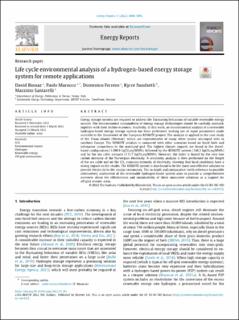| dc.contributor.author | Bionaz, David | |
| dc.contributor.author | Marocco, Paolo | |
| dc.contributor.author | Ferrero, Domenico | |
| dc.contributor.author | Sundseth, Kyrre | |
| dc.contributor.author | Santarelli, Massimo | |
| dc.date.accessioned | 2022-08-02T11:03:07Z | |
| dc.date.available | 2022-08-02T11:03:07Z | |
| dc.date.created | 2022-04-29T13:14:02Z | |
| dc.date.issued | 2022 | |
| dc.identifier.citation | Energy Reports. 2022, 8 5080-5092. | en_US |
| dc.identifier.issn | 2352-4847 | |
| dc.identifier.uri | https://hdl.handle.net/11250/3009773 | |
| dc.description.abstract | Energy storage systems are required to address the fluctuating behaviour of variable renewable energy sources. The environmental sustainability of energy storage technologies should be carefully assessed, together with their techno-economic feasibility. In this work, an environmental analysis of a renewable hydrogen-based energy storage system has been performed, making use of input parameters made available in the framework of the European REMOTE project. The analysis is applied to the case study of the Froan islands (Norway), which are representative of many other insular microgrid sites in northern Europe. The REMOTE solution is compared with other scenarios based on fossil fuels and submarine connections to the mainland grid. The highest climate impacts are found in the diesel-based configuration (1,090.9 kgCO2eq/MWh), followed by the REMOTE system (148.2 kgCO2eq/MWh) and by the sea cable scenario (113.7 kgCO2eq/MWh). However, the latter is biased by the very low carbon intensity of the Norwegian electricity. A sensitivity analysis is then performed on the length of the sea cable and on the CO2 emission intensity of electricity, showing that local conditions have a strong impact on the results. The REMOTE system is also found to be the most cost-effective solution to provide electricity to the insular community. The in-depth and comparative (with reference to possible alternatives) assessment of the renewable hydrogen-based system aims to provide a comprehensive overview about the effectiveness and sustainability of these innovative solutions as a support for off-grid remote areas. | en_US |
| dc.language.iso | eng | en_US |
| dc.publisher | Elsevier | en_US |
| dc.rights | Attribution-NonCommercial-NoDerivatives 4.0 Internasjonal | * |
| dc.rights.uri | http://creativecommons.org/licenses/by-nc-nd/4.0/deed.no | * |
| dc.subject | Off-grid communities | en_US |
| dc.subject | Renewable energy | en_US |
| dc.subject | Hydrogen | en_US |
| dc.subject | Environmental impact | en_US |
| dc.subject | LCA | en_US |
| dc.title | Life cycle environmental analysis of a hydrogen-based energy storage system for remote applications | en_US |
| dc.title.alternative | Life cycle environmental analysis of a hydrogen-based energy storage system for remote applications | en_US |
| dc.type | Peer reviewed | en_US |
| dc.type | Journal article | en_US |
| dc.description.version | publishedVersion | en_US |
| dc.rights.holder | © 2022 The Authors. Published by Elsevier Ltd | en_US |
| dc.source.pagenumber | 5080-5092 | en_US |
| dc.source.volume | 8 | en_US |
| dc.source.journal | Energy Reports | en_US |
| dc.identifier.doi | 10.1016/j.egyr.2022.03.181 | |
| dc.identifier.cristin | 2020144 | |
| dc.relation.project | EC/H2020/779541 | en_US |
| cristin.ispublished | true | |
| cristin.fulltext | original | |
| cristin.qualitycode | 1 | |

